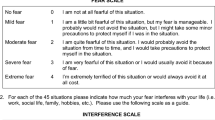Abstract
Normative data for the Fear Questionnaire (Marks & Mathews, 1979), a popular self-report instrument measuring phobic concerns, were collected from both a community and a collegiate sample. The covariation and internal consistency of the blood-injury phobia (BI), social phobia (SO), and agoraphobia (AG) subscales were assessed in each sample, and the factor structure of the items from these three subscales was examined. Results indicated that, in general, community subjects reported more phobic concerns than did collegiate subjects, and females reported greater phobic concerns than did males. Results from confirmatory factor analyses suggest that the three factors of BI, SO, and AG did not emerge from either data set. Follow-up exploratory factor analyses did identify the general factors of blood-injury phobia and agoraphobia. Normative data from the present study are compared to those obtained previously, and directions for future research are provided.
Similar content being viewed by others
References
Barlow, D. H., & Wadell, M. T. (1985). Agoraphobia. In D. H. Barlow (Ed.),Clinical handbook of psychological disorders (pp. 1–68). New York: Guilford.
Bentler, P. M., & Bonett, D. G. (1980). Significance tests and goodness of fit in the analysis of covariance structures.Psychological Bulletin, 88, 588–606.
Chambless, D. (1985). Agoraphobia. In M. Hersen & A. S. Bellack (Eds.),Handbook of clinical behavior therapy with adults (pp. 49–87). New York: Plenum.
Cole, D. A. (1987). Utility of confirmatory factor analysis in test validation research.Journal of Consulting and Clinical Psychology, 55, 584–594.
Comrey, A. L. (1988). Factor-analytic methods of scale development in personality and clinical psychology.Journal of Consulting and Clinical Psychology, 56, 754–761.
Cronbach, L. J. (1951). Coefficient alpha and the internal structure of tests.Psychometrika, 16, 297–334.
Hallam, R. S., & Hafner, R. J. (1978). Fears of phobic patients: Analyses of self-report data.Behaviour Research and Therapy, 16, 1–6.
Himadi, W. G., Boice, R., & Barlow, D. H. (1986). Assessment of agoraphobia. II. Measurement of clinical change.Behaviour Research and Therapy, 24, 321–332.
Jacobson, N. S., & Revenstorf, D. (1988). Statistics for assessing the clinical significance of psychotherapy techniques: Issues, problems, and new developments.Behavioral Assessment, 10, 133–145.
Joreskog, K. G. (1969). A general approach to confirmatory maximum likelihood factor analysis.Psychometrika, 34, 183–202.
Joreskog, K. G., & Sorbom, D. (1984).Lisrel VI: Analysis of linear structural relationships by the method of maximum likelihood (User's guide). Mooresville, IN: Scientific Software.
Kendall, P. C., & Norton-Ford, J. D. (1982). Therapy outcome research methods. In P. C. Kendall & J. N. Butcher (Eds.),Handbook of research methods in clinical psychology (pp. 429–460). New York: Wiley.
Lavrakas, P. J. (1987).Telephone survey methods: Sampling, selection, and supervision. Newbury Park, CA: Sage.
Marks, I. M., & Mathews, A. M. (1979). Brief self-rating for phobic patients.Behaviour Research and Therapy, 17, 263–267.
Mavissakalian, M. (1986). The Fear Questionnaire: A validity study.Behaviour Research and Therapy, 24, 83–85.
Michelson, L. (1987). Cognitive-behavioral assessment and treatment of agoraphobia. In L. Michelson & L. M. Ascher (Eds.),Anxiety and stress disorders: Cognitive-behavioral assessment and treatment (pp. 213–279). New York: Guilford.
Mizes, J. S., & Crawford, J. (1986). Normative values on the Marks and Mathews Fear Questionnaire: A comparison as a function of age and sex.Journal of Psychopathohgy and Behavioral Assessment, 8, 253–262.
Neitzel, M. T., & Trull, T. J. (1988). Meta-analytic approaches to social comparisons: A method for measuring clinical significance.Behavioral Assessment, 10, 159–169.
Nietzel, M. T., Russell, R. L., Hemmings, K. A., & Gretter, M. L. (1987). The clinical significance of psychotherapy for unipolar depression: A meta-analytic approach to social comparison.Journal of Consulting and Clinical Psychology, 55, 156–161.
Robins, L. N., Helzer, J. E., Weissman, M. M., Orvaschel, H., Gruenberg, E., Burke, J. D., & Reiger, D. A. (1984). Lifetime prevalence of specific psychiatric disorders in three sites.Archives of General Psychiatry, 41, 949–958.
Trull, T. J., Nietzel, M. T., & Main, A. (1988). The use of meta-analysis to assess the clinical significance of behavior therapy for agoraphobia.Behavior Therapy, 19, 527–538.
Author information
Authors and Affiliations
Rights and permissions
About this article
Cite this article
Trull, T.J., Hillerbrand, E. Psychometric properties and factor structure of the Fear Questionnaire phobia subscale items in two normative samples. J Psychopathol Behav Assess 12, 285–297 (1990). https://doi.org/10.1007/BF00965984
Accepted:
Issue Date:
DOI: https://doi.org/10.1007/BF00965984




